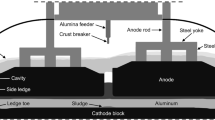A three-dimensional nonstationary model of a 600 kA electrolytic cell is described. The mathematical model describes the electrolysis processes occurring in the cell. The assumptions underlying the model are justified. The dependence of the process on raw materials is shown and taken into account in the model.







Similar content being viewed by others
References
V. N. Smirnov, A. V. Popov, and V. V. Evseev, “Developing a technology of baking RA-300 electrolytic cells,” in: RUSAL Engineering and Economic Bulletin [in Russian], Krasnoyarsk (2006), pp. 24–27.
S. G. Shakrai, P. V. Polyakov, G. V. Arkhipov, E. R. Shaidulin, and A. V. Sman’, “Anode mass cover as an aluminum electrolyzer subsystem,” Metallurgist,58, No. 11-12, 1128–1135 (2015).
A. D. Smol’nikov, V. Yu. Bazhin, and P. A. Petrov, “Elektroliz 600+ concept of power-effective aluminum production,” in: Intern. Research J., No. 5 (47), Part 3, Ekaterinburg (2016), pp. 37–40.
V. Bojarevics and K. Pericleous, “Solutions for the metal–bath interface in aluminium electrolysis cells,” Light Metals, 569–574 (2009).
Lu Dingxiong, Mao Jihong, Ban Yungang, and Qi. Xiquan, “Development of NEUI500k. A family high energy efficiency aluminum reduction pot (“HEEP”) technology,” Light Metals, 455–460 (2011).
S. Lindsay and N. Dando, “Dry scrubbing for modern pre-bake cells,” Light Metals, 275–280 (2009).
L. E. Kondrat’eva, Foundations of the Finite-Element Method (A Compendum of Lectures) [in Russian], Vladim. Gos. Univ., Vladimir (2007).
A. Ya. Karvatskii, G. N. Vasil’chenko, and V. V. Bil’ko, “Numerical simulation for calculating the energy balance of an aluminum electrolysis cell,” Promyshl. Teplotekhn.,30, No. 2, 33–40 (2008).
I. N. Korostelev, Mathematical Model of Stationary Physical Fields and MHD Stability Criterion in the Algorithms of a Dynamic Model of an Aluminum Electrolysis Cell [in Russian], PhD Thesis, 05.13.18, RGB, Moscow (2005).
A. D. Smol’nikov and V. Yu. Sharikov, “Simulating the electrolysis of aluminum in a high-current electrolytic cell by the finiteelement method,” Vestn. Sovr. Issled. (ISSN 2541-8300), No. 6-1 (21), 551–553 (2018).
A. B. Mazo, Foundations of the Heat-Transfer Theory and Methods [in Russian], Kazan. Univ., Kazan (2013).
I. V. Sharikov and F. I. Sharikov, “Control systems using mathematical models of technological objects in the control loop,” J. Fundam. Appl. Sci., No. 9 (7S), 815–833 (2017).
Y. V. Sharikov and A. A. Markus, “Mathematical modeling of thermal fields in a fragment of the lining of a rotary kiln,” Metallurgist,57, No. 11-12, 1062–1066 (2014).
P. A. Petrov, Y. V. Sharikov, A. A. Vlasov, V. Y. Bazhin, and A. Y. Feoktistov, “Developing software for the feed-control systems of high-power aluminum reduction cells,” Metallurgist,58, No. 11–12, 1060–1063 (2015).
Author information
Authors and Affiliations
Corresponding authors
Additional information
Translated from Metallurg, Vol. 63, No. 12, pp. 67–71, December, 2019.
Rights and permissions
About this article
Cite this article
Smol’nikov, A.D., Sharikov, Y.V. Simulation of the Aluminum Electrolysis Process in a High-Current Electrolytic Cell in Modern Software. Metallurgist 63, 1313–1320 (2020). https://doi.org/10.1007/s11015-020-00953-6
Received:
Published:
Issue Date:
DOI: https://doi.org/10.1007/s11015-020-00953-6




